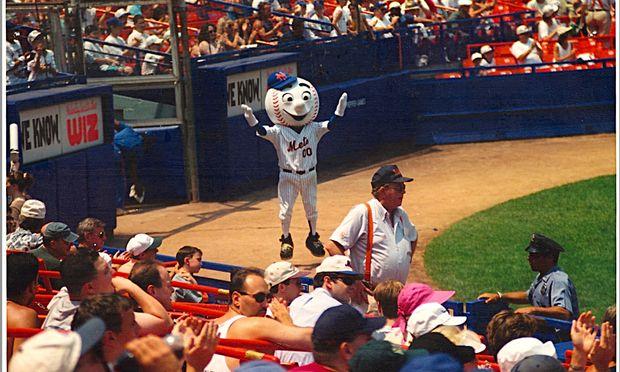Being a sports team mascot isn’t all fun and games. Just ask Mr. Met.
AJ Mass appears as Mr. Met.
When AJ Mass first donned the Mr. Met costume in 1994, the hot strain of the wool and metal costume was a refreshing alternative to being gakked and slimed.
“They actually decided to put a theme park in the outfield, behind the wall, in conjunction with Nickelodeon,” Mass says. “The team had lost 103 games the year before, so they were really looking for an excuse to get people to come to the ballpark.”
When Mass heard that the team was bringing back their retired mascot, Mr. Met, his transformation into a beloved major league mascot started with a quirk of chance.
“I fit the suit, so I got the job,” he says.
Few major league mascots inspire the love and devotion that Mr. Met does. Rivaling only the Phillie Phanatic in the pantheon of baseball mascots, Mr. Met has become synonymous with a region’s selfless devotion to a beloved team, overlooking its inconsistent on-field record in favor of the buoyant off-field persona embodied by its mascot.
Mass grew up a 15-minute walk away from Shea Stadium in Flushing Queens — a Mets fan not so much by choice as by nature.
“You could actually see the rim of the stadium and the fireworks from my bedroom window off in the distance,” Mass says. “One of the things that I tried to do … [was] to create a Mets personality, something that would fit in Flushing. Being from Flushing and being a Mets fan and knowing the culture, I think that certainly helped me achieve the goal.”
For him, performing on the field at Shea went part of the way to fulfilling a boyhood fantasy.
“I had dreams of being a Major League Baseball player, and suddenly there I am," he says. "The first thing I did is I made a beeline for right behind first base. I stood right where Bill Buckner stood on the infamous play in ’86. And I just kind of looked around and said, ‘Yeah. This is pretty cool.’”
Mass put his acting and improv background to work when he started performing as a mascot.
“Everything’s got to be really big when you're on the field, because it has to read in the back row and the back row is very, very far away,” Mass says. “I don't think a lot of organizations realize how much actually does go into having a performer in there, instead of just taking the intern who draws the short straw that day and sticking them in the suit.”
One of his unofficial duties, Mass recalled wryly, was to take physical abuse from angry fans.
“If the team is losing sometimes you get shoved, and certainly when you throw alcohol into the mix, and the close proximity to Yankees fans who may not like the Mets, you need to have a bodyguard with you," he says.
One infamous story, which opens Mass’s memoir "Yes, It’s Hot in Here: Adventures in the Weird, Woolly World of Sports Mascots," involves presidential bodyguards, who were armed with more than beer bottles.
“We have snipers all around the stadium,” a Secret Service agent says in Mass’s book. “Approach the president, and we go for the kill shot. Are we clear?”
Mass said that though the agent was deadly serious, the vaunted “kill shot” might just have been the verbal threat itself.
“I think the goal was to scare me to the point where it wouldn't be an issue," Mass says. "Do I really think they were going to take a shot at me? Probably not. There are other ways you could have subdued me, certainly.”
Mr. Met’s usual routines and the attitudes of the Mets organization proved more harmful to Mass’s health and livelihood than Secret Service snipers or drunken shoving. When Mass developed a knee injury and asked the Mets organization for health insurance, they fired him in a curt e-mail after the end of the 1997 season.
Despite his abrupt dismissal, Mass has remained sanguine, if ambivalent, about his time with the Mets, and firmly claims that the mascot is the keystone of the ballpark experience.
“The thing that makes mascots special is that they’re a part of the history of the team. The players come and go, the manager gets fired and a new manager is hired, but the mascot is always there, and that's one constant,” Mass says. “A parent can take their their kid to the game and say, ‘This is the mascot. This mascot was here when I was a kid.’”
Mass sums up the tension between the business interests of baseball and the gameday fun of the fans this way:
“I’m trying to be professional about this, but my job is to be a professional goofball.
This story first aired as an interview on PRI's The Takeaway, a public radio program that invites you to be part of the American conversation.
Our coverage reaches millions each week, but only a small fraction of listeners contribute to sustain our program. We still need 224 more people to donate $100 or $10/monthly to unlock our $67,000 match. Will you help us get there today?
